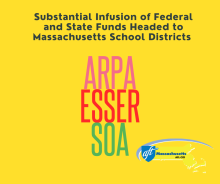Editor’s note: This story was updated in August 2021 to reflect final FY2022 state budget numbers.
There is good news on the horizon for Massachusetts schools and students. Massachusetts school districts are slated to receive more than $2 billion in federal education aid over the coming year, thanks to federal COVID-19 relief packages passed since March 2020, the most recent being the American Rescue Plan Act (ARPA). This federal money, in tandem with promised state-level investments in K-12 education, could have a positive impact on Massachusetts students for years to come.

The four main components of ARPA relevant to education are as follows:
- The Elementary and Secondary School Emergency Relief Fund (ESSER III) provides roughly $1.647 billion for Massachusetts’ local school districts and $183 million for the Mass. Department of Elementary and Secondary Education. This is on top of two previous rounds of ESSER funding (see below).
- The Higher Education Emergency Relief Fund (HEERF III) provides an estimated $439 million for Massachusetts’ public community colleges, state universities and the University of Massachusetts system.
- The Coronavirus State Fiscal Recovery Fund (CSFRF) provides about $5.3 billion to the state government which can be used for COVID crisis-related costs (or to replace lost revenue), including costs in PreK-12 and higher education.
- The Coronavirus Local Fiscal Recovery Fund (CLFRF) provides about $3.4 billion for local governments that can be used for COVID crisis-related costs (or to replace lost revenue), including costs in PreK-12 education.
The ESSER funding stands out as the component that will have the greatest impact on K-12 public schools. Taken together, the three rounds of ESSER funding represent a monumental investment—arguably the single largest investment ever in public education.
ESSER I, II, and III: A Deeper Dive
The ESSER program was designed by the U.S. Congress to address the impacts of COVID-19 on schools and students. The funds are being disseminated to school districts by the Mass. Department of Elementary and Secondary Education (DESE) in three rounds (I, II, and III). The allowable uses are quite broad and flexible, creating a unique opportunity for school districts to address the academic, social, emotional, and mental health needs of students—needs that were in many cases exacerbated by the pandemic.
All told, Massachusetts school districts are slated to receive almost $2.6 billion in federal ESSER funds for use from March 2020 through September 2024. By design, ESSER sends the most money to districts with the highest concentrations of economically disadvantaged students, meaning that Gateway Cities and other low-income communities will generally receive the largest allocations. Key details for each round, as well as links to additional information, are listed below:
ESSER I
Source of funds: Coronavirus Aid, Relief and Economic Security Act (CARES), March 2020
Deadline for districts to apply for funds: Aug. 14, 2020
Deadline for districts to spend funds: Sept. 30, 2022
Total amount to Mass. districts: $193 million
ESSER I district-by-district allocation amounts (DESE)
Allowable uses (U.S. Dept. of Education, see Section A-3, pp. 10-12)
Additional information (DESE)
ESSER II
Source of funds: Coronavirus Response and Relief Supplemental Appropriations Act (CRRSAA), December 2020
Deadline for districts to apply for funds: July 30, 2021
Deadline for districts to spend funds: Sept. 30, 2023
Total amount to Mass. districts: $739 million
ESSER II district-by-district allocation amounts (DESE)
Allowable uses (U.S. Dept. of Education, see Section A-3, pp. 10-12)
Additional information (DESE)
ESSER III
Source of funds: The American Rescue Plan Act (ARPA), March 2021
Deadline for districts to apply for funds: Oct. 4, 2021
Deadline for districts to spend funds: Sept. 30, 2024
Total amount to Mass. districts: $1.647 billion
ESSER III district-by-district allocation amounts (DESE)
Allowable uses (U.S. Dept. of Education link, see Section A-3, pp. 10-12)
Additional information (DESE)
ESSER and the Student Opportunity Act: A Perfect Fit
While ESSER provides substantial new federal education funding, significant new dollars will also arrive to districts over the next six years as a result of the state-level Student Opportunity Act (SOA), a historic school funding law passed in Nov. 2019.
The Legislature and Governor Charlie Baker have indicated their commitment to fully fund SOA over the next six years, with School Year 2021-22 representing the first year of the six-year phase-in. The final FY2022 state budget reflects that commitment, authorizing $5.503 billion in Chapter 70 education aid to Massachusetts school districts, an increase of $219.6 million over FY2021. District-by-district breakdowns of Chapter 70 aid and other key figures related to the FY2022 budget can be found at the DESE website.
The final budget also includes $154.6 million in charter school tuition reimbursements, an increase of $37.2 million over FY2021. And it includes a $40 million reserve fund to address the impact that pandemic-related enrollment loss may have on Chapter 70 aid in some districts. The distribution of these funds will be determined after Oct. 1 enrollment is reported. While this $40 million fund is lower than what education advocates had lobbied for, it could help relieve some of the financial hardship that results from enrollment quickly snapping back to pre-pandemic levels, as is anticipated in many districts.
It is useful to think of the two streams of funding—federal ESSER and state SOA—as working in tandem. Full ESSER funds (from Rounds I, II, and III) will arrive in districts over the next year for use through September 2024. Meanwhile, state SOA monies will ramp up steadily over six years—with new money added each year on top of the previous year’s baseline—until full funding of SOA is achieved in 2027. What this means is that districts could strategically use ESSER funds now to accelerate investments in students and schools (e.g., smaller classes, more social workers and nurses, better wages for paraprofessionals, HVAC improvements, etc.) and then use SOA funds to sustain those investments. The timing is quite conducive to this strategy, with SOA ramping up at the same time that ESSER ramps down.
For questions about ESSER, SOA, or the state budget, please contact AFT Massachusetts.
